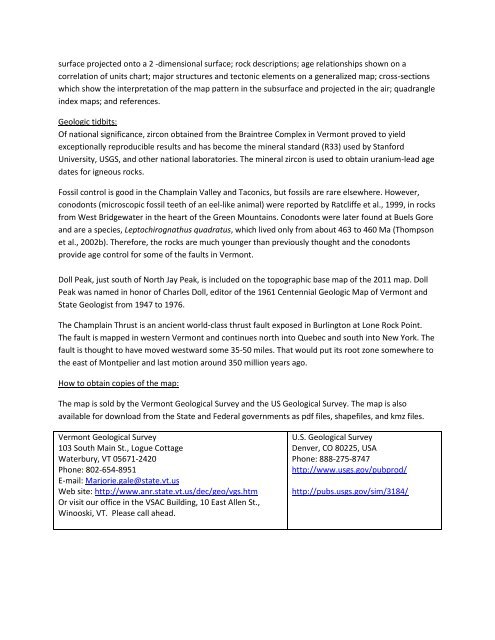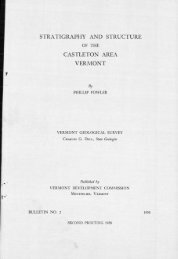The Inside Story - Vermont Agency of Natural Resources
The Inside Story - Vermont Agency of Natural Resources
The Inside Story - Vermont Agency of Natural Resources
You also want an ePaper? Increase the reach of your titles
YUMPU automatically turns print PDFs into web optimized ePapers that Google loves.
surface projected onto a 2 -dimensional surface; rock descriptions; age relationships shown on a<br />
correlation <strong>of</strong> units chart; major structures and tectonic elements on a generalized map; cross-sections<br />
which show the interpretation <strong>of</strong> the map pattern in the subsurface and projected in the air; quadrangle<br />
index maps; and references.<br />
Geologic tidbits:<br />
Of national significance, zircon obtained from the Braintree Complex in <strong>Vermont</strong> proved to yield<br />
exceptionally reproducible results and has become the mineral standard (R33) used by Stanford<br />
University, USGS, and other national laboratories. <strong>The</strong> mineral zircon is used to obtain uranium-lead age<br />
dates for igneous rocks.<br />
Fossil control is good in the Champlain Valley and Taconics, but fossils are rare elsewhere. However,<br />
conodonts (microscopic fossil teeth <strong>of</strong> an eel-like animal) were reported by Ratcliffe et al., 1999, in rocks<br />
from West Bridgewater in the heart <strong>of</strong> the Green Mountains. Conodonts were later found at Buels Gore<br />
and are a species, Leptochirognathus quadratus, which lived only from about 463 to 460 Ma (Thompson<br />
et al., 2002b). <strong>The</strong>refore, the rocks are much younger than previously thought and the conodonts<br />
provide age control for some <strong>of</strong> the faults in <strong>Vermont</strong>.<br />
Doll Peak, just south <strong>of</strong> North Jay Peak, is included on the topographic base map <strong>of</strong> the 2011 map. Doll<br />
Peak was named in honor <strong>of</strong> Charles Doll, editor <strong>of</strong> the 1961 Centennial Geologic Map <strong>of</strong> <strong>Vermont</strong> and<br />
State Geologist from 1947 to 1976.<br />
<strong>The</strong> Champlain Thrust is an ancient world-class thrust fault exposed in Burlington at Lone Rock Point.<br />
<strong>The</strong> fault is mapped in western <strong>Vermont</strong> and continues north into Quebec and south into New York. <strong>The</strong><br />
fault is thought to have moved westward some 35-50 miles. That would put its root zone somewhere to<br />
the east <strong>of</strong> Montpelier and last motion around 350 million years ago.<br />
How to obtain copies <strong>of</strong> the map:<br />
<strong>The</strong> map is sold by the <strong>Vermont</strong> Geological Survey and the US Geological Survey. <strong>The</strong> map is also<br />
available for download from the State and Federal governments as pdf files, shapefiles, and kmz files.<br />
<strong>Vermont</strong> Geological Survey<br />
103 South Main St., Logue Cottage<br />
Waterbury, VT 05671-2420<br />
Phone: 802-654-8951<br />
E-mail: Marjorie.gale@state.vt.us<br />
Web site: http://www.anr.state.vt.us/dec/geo/vgs.htm<br />
Or visit our <strong>of</strong>fice in the VSAC Building, 10 East Allen St.,<br />
Winooski, VT. Please call ahead.<br />
U.S. Geological Survey<br />
Denver, CO 80225, USA<br />
Phone: 888-275-8747<br />
http://www.usgs.gov/pubprod/<br />
http://pubs.usgs.gov/sim/3184/













